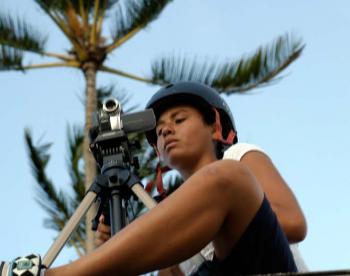KOPO: radiOpio

20 years ago, “community members, recognizing the many needs of local youth, got together and Paia Youth & Cultural Center was born,” said Laura Civitello, Program Director of KOPO-LP and youth program of radiOpio. The PYCC made its home in the last building standing after a tsunami swept away the rest of the neighborhood in 1946. Their location has since transformed from a fire-charred, graffiti-covered house to a beach-side recreational drop-in center with a skate park, cooking program, film and music production, computer lab, adventure/challenge program, and dedicated long-term staff.
In 1999, PYCC employee Travis Rice and other interested folks began the LPFM application process. In 2005, they got their construction permit and started building. “Very few people on the Maui radio scene had much faith that youth ages 9 and up could operate a station and time was ticking to find a director for the station/youth program,” Civitello recalled. She “stepped up and began climbing a learning curve to design and erect the station and to learn the language of non-profit youth services.” With the help of engineer Jim Hall, KOPO-LP went on air in June 2006 as an anti-drug/violence program funded by the State of Hawaii Office of Youth Services.
Named for the Hawaiian word "opio," meaning "youth," the station has stayed committed to serving the area's preteen and adolescent community. In a three-month period, between forty and sixty youth participate, and many stay involved for years. “Over the years, hundreds of Maui’s youth have made good use of radiOpio," says Civitello of the station's community impact. "Access to ...radio can play an important role in youth’s development." Volunteering at the station helps youth further hone their reading, writing, and interpersonal skills as they work together to keep the station thriving. As a result, Civitello suggests, "The responsibility of station operations heightens self-confidence."
The young DJs learn that they can in fact operate the station and “are willing to challenge their reading and speaking abilities in promos and PSAs.” Audiences delight in the sound of kids just being kids. And, Civitello jokes, “Of course, they're always good for a promotional flyer or 20.” In terms of station management, Civitello notes, “The station primarily functions as one of PYCC's youth programs, so a lot of the issues of having to keep a station supported as a separate entity are taken care of.”
radiOpio has produced a broad spectrum of programming, from original radio theater and "Astrofacts," which was funded by MIT and stimulated youths' interest in astronomy, to youths' music, essays, and PSAs. "The seldom-heard voices of youth make a lovely, lively, and often flat-out hilarious sound," Civitello says. Young DJs have regularly scheduled shows or jump on air when the station's available.
While radiOpio hasn't surveyed their audience, they get “lots of positive feedback from listeners.” Since there are many hours of the day that youth can't run the station, Civitello programs “a lot of new and alternative music that isn't being heard elsewhere on the dial…deeper soul, reggae, folk, blues, and jazz cuts that appeal to older, sophisticated listeners.” By engaging “20-40-somethings,” more people become aware of the PYCC and are more inclined to support it.
radiOpio has become a haven of creativity for Pa'ia's youth. “One of the greatest impacts has been...the deep and long-lasting relationships grown in the sanctuary of the studio. Giving youth the increased level of trust and responsibility of broadcasting has been empowering and beneficial to all participants. And there has certainly been a heightened awareness of youth and their abilities in our community,” says Civitello. If this all seems too good to be true, Civitello is happy to answer questions that other groups might have about including youth in community radio. “The mission of the Pa‘ia Youth & Cultural Center is to build community through youth, and radiOpio serves that vision. What better way for youth to feel a part of the community than through the direct contact of radio?” says Civitello. As a final note she reminds all LPFM hopefuls, “Never underestimate the value of having youth involved!”
Thanks to Beth Patel and Lucy Saunders-Pappentick for putting together this profile.
